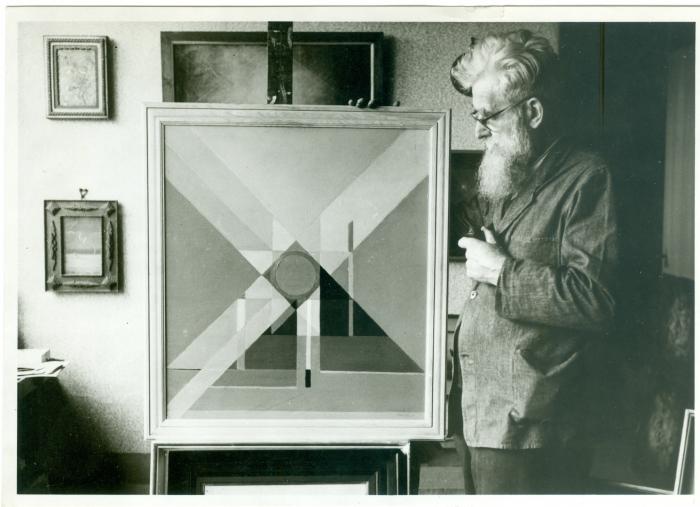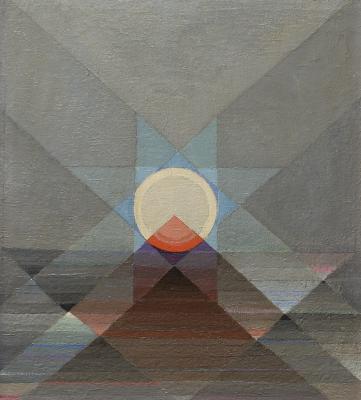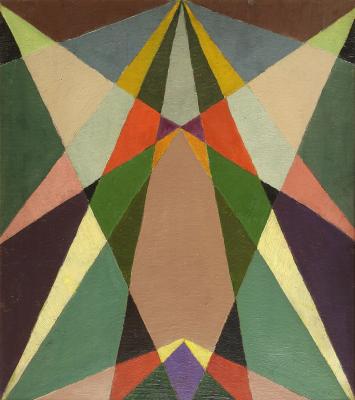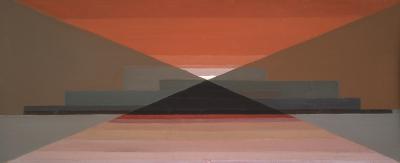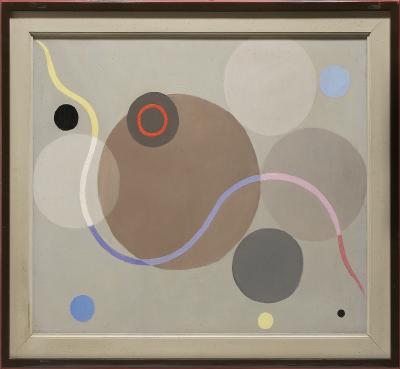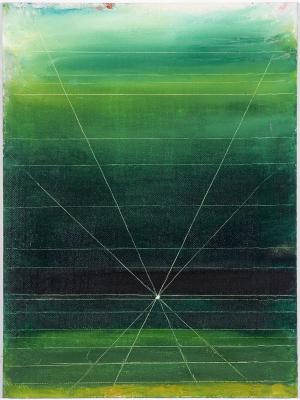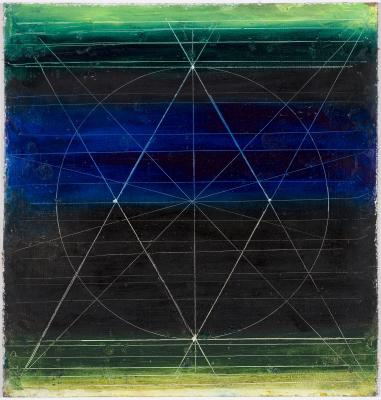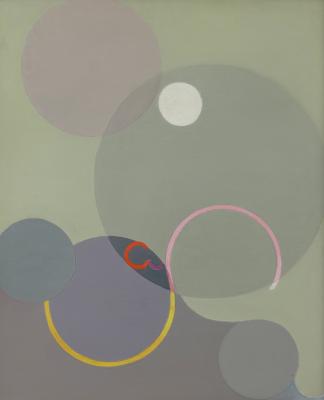The autodidact and son of a farmer, Felix De Boeck has a unique artistic trajectory. Encouraged by Prosper De Troyer (1880 - 1961), beginning in 1917, De Boeck switches Post-Impressionism for an expressive Fauvism and Futurism. During the final years of World War I, De Boeck exhibits in Brussels with the group Doe Stil Voort, where he meets other young men such as Jozef Peeters and Victor Servranckx. In 1919, he comes into contact with Pierre-Louis Flouquet (1900 - 1967) and the Bourgeois brothers. Pierre (1898 - 1976) is a writer and Victor Bourgeois (1897 - 1962) is an architect. De Boeck meets the latter in the Brussels Centre d’Art, where he attends a presentation by Theo Van Doesburg (1883 - 1931) on the Neo-Plasticism and De Stijl.
De Boeck paints geometrical and circular abstract masks as a reaction to the economic and social upheaval of the First World War and the desire to ‘build a new world’. His work evolves during a short period (1919 - 1921) towards the abstract via an extreme stylising of the masks and landscapes. Quickly the clean two-dimensional gives way to a sense of depth that is suggested by a play of diagonals and degradations of colour. The abstract space that thus ensues, with a primary emphasis on the central point, becomes a returning mystical element throughout his entire oeuvre. In 1923, De Boeck receives a richly illustrated article in the two avant-garde publications in Belgium, 7 Arts and Het Overzicht.
After 1925 De Boeck becomes a member of the group L’Assaut, where along with Jean-Jacques Gailliard, Servranckx and Flouquet, among others, he emphasises the link between the expressive arts and theatre. From 1930, his work becomes outspokenly figurative, whereby philosophical and religious themes are symbolically addressed. His figuration becomes, in line with Boleslas Biegas’ (1877 - 1954) ‘sphérisme’, characterised by a circular construction and the use of a compass. Under the influence of Desiderius Lenz’s (1832 - 1928) school of Beuron, he shall use geometry throughout his oeuvre for making idealised portraits and landscapes. After the collapse of the Abstract movement, De Boeck stays in contact with artists and writers such as Herman Teirlinck and Maurice Carème.
His farmstead in Drogenbos, which already in the 1920’s was visited by Frits Van den Berghe and Albert Daenens, among others, becomes a meeting ground for old and new contacts. This remains true until his death. As with many of his generation he returns to the abstract in the 1960’s, when the pioneers of the movement are rediscovered. Only during his final years (1980 - 1995) does he create a synthesis with the themes of Space and Begin and Endpoint that is abstract by nature.
1898
Felix Henricus Constantinus De Boeck is born on 12 January in Drogenbos to a family of farmers.
1909 - 1915
De Boeck meets Pol Craps (1877 - 1939), an etcher from Drogenbos, who teaches him how to draw. Louis Thévenet (1874 - 1930), one of the regional painters who is associated with Brabant Fauvism, acquaints him with oil painting after his schooling.
1917 - 1918
De Boeck becomes a member of the art circle Doe Stil Voort. He takes part in the summer exhibition in the Museum of Contemporary Paintings in Brussels, where he displays his Fauvist work. De Boeck meets De Troyer, who introduces him to Modern Art, specifically Futurism. De Boeck evolves in the direction of the Pure Plasticism.
1919 - 1921
De Boeck becomes acquainted with the Brussels avant-garde in ‘Le Centre d’Art’. In addition, he has contact with Michel de Ghelderode (1898 - 1962) and Jan Boon of the Flemish Folk Theatre.
In October 1920, he becomes a member of the Kring Moderne Kunst along with Karel Maes, De Troyer, Joris Minne (1886 - 1941), and Huib Hoste, among others. He attends the presentation by Theo Van Doesburg about the ‘New expressive art’. For a year, De Boeck works strictly geometrically.
Edouard Leon Theodore Mesens (1903 - 1971) is a musician, painter and writer and visits De Boeck’s studio along with Wies Moens (1898 - 1982). Moens engages in an intense correspondence with the artist and writes an article on his work in the publication Pogen.
1922
De Boeck sympathises with and joins the group 7 Arts. The founders are: architect Victor Bourgeois, writer Pierre Bourgeois, playwright Georges Monier (1892 - 1973) and painters Pierre-Louis Flouquet and Karel Maes. De Boeck participates in the ‘Second Congress for Modern Arts’ organised by Jozef Peeters in Antwerp.
1923 - 1925
Participates in the group exhibition Les Arts Belges d’esprit nouveau in the Egmont Palace in Brussels. This is an organisation of the group La Lanterne Sourde.
The populating of animals and insects in his abstract landscapes is the starting point from what shall later be called the Genesis series. On 24 May 1924, De Boeck marries Marieke Van Breetwater. The couple lose four children.
De Boeck is the co-founder of L’Assaut and participates in the Salons in Brussels, Paris and Milan.
1927
First individual exhibition in Zaal Delgay (Koningsstraat 138, Brussels). In 7 Arts an article by Flouquet appears in which he underscores the connection with Nature, the sensitive approach and fundamental soundness of De Boeck.
Group exhibition L’Art belge in the Musée of Grenoble. The museum acquires a work from the series Omtrent een geboorte.
1930 - 1953
Although he remains extremely productive, De Boeck shall exhibit little for twenty years. As it is since 1925 De Boeck is financially independent thanks to his agricultural practice.
Is invited for the International Exhibition for Modern Arts within the frame of the World’s Exhibition in Brussels (1935).
In 1952 he receives a retrospective exhibition in Galerij Georges Giroux (Regentlaan 43, Brussels). During the occasion the book Felix De Boeck by Jan Walravens is presented.
In 1953 he participates in the group exhibition Troisième Salon d’Art Sacré in the Museum of Modern Arts in Paris.
1956 - 1963
Individual exhibition and comeback with fluorescent works, entitled Peinture expérimentales in Galerij Saint-Laurent in Brussels. Takes up geometric and abstract themes again on a small scale. Group exhibition De eerste abstracten in België—Hulde aan de pioniers (The First Abstracts in Belgium—Honouring the Pioneers) in the G 58 Hessenhuis in Antwerp.
1964 - 1981
Group exhibition with the collection of the Bank for Paris and the Netherlands in the Stedelijk Van Abbemuseum in Eindhoven in 1965.
Receives a large retrospective exhibition in the Museum of Fine Arts in Elsene. Presentation of a second monograph by critic Jan Walravens.
In 1969, the Felix De Boeck Museum opens in the uppermost floor of the town hall in Drogenbos. Official donation of some 70 works to the Ministry of Culture on 22 March 1972.
In the 1970’s, De Boeck’s work is shown in international group exhibitions by Galerie Gmurzynska (Cologne) and Gallery Annely Juda Fine Art (London), inter alia.
De Boeck receives an individual exhibition Van Punt tot Cirkel (From Point to Circle) in the Royal Museums of Fine Arts of Belgium in Brussels.
1988
Receives the Staatsprijs for Expressive Arts.
1994 - 1995
The symbolic first stone for a museum is laid by Hugo Weckx, the Flemish Minister of Culture and Brussels Affairs in the presence of federal Premier Jean-Luc Dehaene. The modern museum building opens in 1996 on the property of Felix De Boeck.
Felix De Boeck dies on 18 January 1995 in Sint-Agatha-Berchem.
Sergio Servellón
CC-BY-NC (Creative Commons 4.0)
